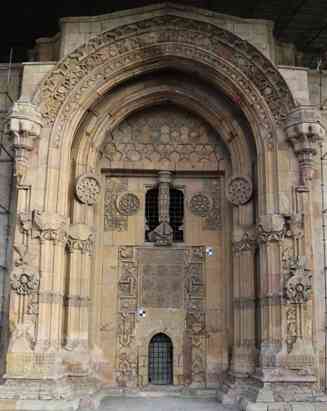 The Divrigi Ulu (Grand) Mosque and Darüssifa (Hospital) is located in Divrigi district of Sivas province. The mosque was built by Ahmet Shah and his wife Turan Melek in 1228-1229 when the region was under the rule of Mengücekliler, the reigning dynasty in eastern Anatolia following the victory of the Seljuks over the Byzantines at the battle of Malazgirt in 1071. The architect was Hürrem Shah from Ahlat town who built this amazing stone building, which became a masterpiece of Islamic architecture and called as "Anatolia's Alhambra" today. It's a rich example of Anatolian traditional stonework in a baroque architectural style and has no equal in Turkish and Islamic Art.
The Divrigi Ulu (Grand) Mosque and Darüssifa (Hospital) is located in Divrigi district of Sivas province. The mosque was built by Ahmet Shah and his wife Turan Melek in 1228-1229 when the region was under the rule of Mengücekliler, the reigning dynasty in eastern Anatolia following the victory of the Seljuks over the Byzantines at the battle of Malazgirt in 1071. The architect was Hürrem Shah from Ahlat town who built this amazing stone building, which became a masterpiece of Islamic architecture and called as "Anatolia's Alhambra" today. It's a rich example of Anatolian traditional stonework in a baroque architectural style and has no equal in Turkish and Islamic Art.
The complex consists of a mosque with a two-domed tomb and a hospital. In the Darüssifa (hospital), a two-storey building with a roofed courtyard built adjacent to the mosque, mental patients were cured with the sound of water. There are four major stone gates with their distinct and unique decorations: Crown Gate of Darüssifa, North Crown Gate (Paradise Gate) of the mosque, West Crown Gate, and Shah Mahfili Crown Gate. These portals have three-dimensional high relief, asymmetrical, floral and geometric figures on the stone which is embroidered like lace, close to the sculpture. One of the interesting characteristics of the stone work of this structure is; especially between May and September when the afternoon sun falls on the Western door of the mosque, the shadow of a standing male silhouette appears from the side. Meanwhile in the early morning hours at the Paradise gate there is another rectangular shadow which looks like a female silhouette. It is believed that these shadows are a man and woman reading the Qur'an and praying.
The complex is on the UNESCO World Heritage List since 1985. The building is under extensive restoration since 2015, hence can be seen only from outside. The restoration work is planned to be completed by 2024.

